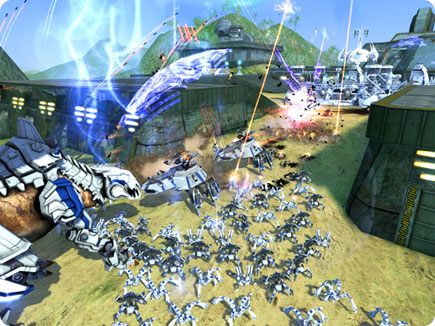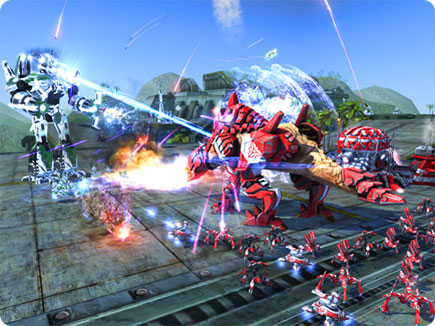That big ol’ war machine — technically, an Armored Command Unit (ACU) — thrums to life as I switch on its systems. Supreme Commander 2 lead designer Chris Taylor sits at the controls of another ACU, and he’s ready to lead me through the paces. His voice crackles over a speaker: “The biggest lesson we learned from the first game was that creating a big game means really focusing on what’s important.
“We were very ambitious and had a huge list of features, but we honed in on what was key, like the performance of the game engine, interesting units that are highly detailed, and creating maps that are far and away more interesting to play on.”

Heavily Fortified. Now it’s time to put all that defense planning to the test.
“One lesson I have learned from previous RTS games is that we need to create experiences people can relate to. It’s as simple as that.”
- Chris Taylor, lead designer
The Key is Strategic Zoom
From our vantage point, we have a good look at the ACU controlled by Commander Dominic “Migraine” Maddox, who has orders to protect the planet’s communications array from a Cybran attack that’s under way. Maddox marshals his forces against the invaders, who threaten to overrun a facility that sits atop a forest-covered plateau. UEF Rock Head Tanks repel the invaders, and Maddox uses the brief respite to produce replacement units at his factories.

Time For a Raid. Stopping that Cybranosaurus Rex bringing up the rear won’t be easy.
“Supreme Commander 2 allows you to create huge armies of units, whether they’re land, sea, or air, and take them into large, outrageous, and over-the-top battles,” Taylor explains. “When you add a feature like Strategic Zoom, which supports small units and very large units on screen at the same time, you have an RTS experience like no other. Strategic Zoom is what makes it all possible.”
With Strategic Zoom, Maddox was able to deal with Cybran troops breaching the facility in multiple locations. While he had a contained area to worry about, Strategic Zoom becomes even more important during later episodes in the 18-mission campaign, as battles can span miles in all directions.

A Long Shadow. An ACU (Armored Command Unit) leads its forces into battle.
And those Rock Head Tanks, while basic units now, can take on increasingly-powerful enemies, thanks to upgrades available through the research tree, which Taylor says “creates depth to the gameplay in a new and more interesting way. The technology research tree allows early units to be useful at the end of the game.” In addition, he points out that such functionality only became possible thanks to the decision to minimize the available units. “Fewer units also meant we could spend more time on each one and create more interesting relationships between them,” he notes.
Game Hardware
Check out our systems for your best gaming experience.
- Site: Supreme Commander 2
- Publisher: Virtual Programming
- Developer: Gas Powered Games
- Genre: Strategy
Game Media
“Supreme Commander 2 allows you to create huge armies of units, whether they’re land, sea, or air, and take them into large, outrageous, and over-the-top battles.”
- Chris Taylor, lead designer
Three Perspectives
Commander Maddox’s storyline is the first of three in Supreme Commander 2’s campaign. Taylor lays out the progression: “We start out with a husband and wife, then move to a brother/sister duo, and the last chapter is between a father and son. We thought it would be far more interesting than spending all the time in the war room getting briefings on what to destroy next. The primary theme we wanted to explore is the complex dynamics between family members caught up in war.”

Clash of the Titans. An Aeon Galactic Colossus goes head-to-head against a Cybranosaurus Rex.
In Maddox’s case, his wife is an Illuminate, a fact that caused a rift with his parents, who eventually came to terms with the relationship. (To learn more about the game’s back story, see “War and Peace” on page two.) Even though all three factions under the CDC are comprised of humans, the assassination of the CDC president brings out old distrust.
“While playing the first set of missions, you might notice there is a strong theme borrowed from World War II,” Taylor says. “We wanted to keep the time elapsed after the end of the first game short enough that players could connect with the fiction without having to learn too much about the story world and what had happened in the meantime. One lesson I have learned from previous RTS games is that we need to create experiences people can relate to. It’s as simple as that.”

Armored Assault. Cybran forces overwhelm an Aeon base.
The conversation lapses into silence as we turn our attention to Maddox’s current situation. A group of C-18 Star Lifters recently arrived, giving the commander more options should he need to quickly transport units across the map, but a new wave of Cybran forces have also shown up, led by a pair of powerful units known as experimentals. (All three factions have access to experimental units.)
Maddox is forced to throw everything he has at the assault, but that battle will prove to be insignificant when a later mission sends him off to attack an Illumiate colony where his wife and son live. Loyalties will be tested, and the war won’t be so simple anymore. Taylor and I settle in to watch it all unfold.
If you liked these games, check out:
- Age of Empires III
- Age of Empires III: The Asian Dynasties
- Age of Empires III: The WarChiefs
- Civilization IV: Colonization
- Command & Conquer Generals
- Command & Conquer Generals: Zero Hour
- Command & Conquer Red Alert 3
- Command & Conquer 3 Tiberium Wars
- Defense Grid: The Awakening
- Imperial Glory
- Rome: Total War Gold Edition
- StarCraft II: Wings of Liberty
- Star Wars: Empire at War


